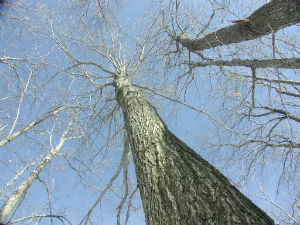 The Earth's climate has changed and is projected to continue to change because of a rapid and dramatic increase in the concentration of greenhouse gases (GHGs) in the atmosphere due to the burning of fossil fuels and land-use change. Forests play an important role in reducing the amount of carbon dioxide (CO2) in the air because they take in CO2 through photosynthesis and store the carbon in their wood, branches, foliage, and roots. Carbon can be stored for extended periods of time in trees and soils (referred to as "carbon storage" or "carbon stocks"), and healthy trees continue to take in additional CO2 on a yearly basis (referred to as “carbon sequestration”). But, forests are also impacted by the changing climate, like warmer winters and more frequent heavy rainfall events.
The Earth's climate has changed and is projected to continue to change because of a rapid and dramatic increase in the concentration of greenhouse gases (GHGs) in the atmosphere due to the burning of fossil fuels and land-use change. Forests play an important role in reducing the amount of carbon dioxide (CO2) in the air because they take in CO2 through photosynthesis and store the carbon in their wood, branches, foliage, and roots. Carbon can be stored for extended periods of time in trees and soils (referred to as "carbon storage" or "carbon stocks"), and healthy trees continue to take in additional CO2 on a yearly basis (referred to as “carbon sequestration”). But, forests are also impacted by the changing climate, like warmer winters and more frequent heavy rainfall events.
Climate Change in Vermont
The Vermont Climate Assessment (2021) provides an analysis of climate change in Vermont and the potential impacts of these changes.
There is strong evidence that Vermont’s climate is changing. Vermont is becoming warmer (average annual temperature is about 2°F warmer since 1900), and Vermont’s winters are becoming warmer more quickly (winter temperatures have warmed 2.5x more quickly than average annual temperature since 1960). Vermont is also becoming wetter (average annual precipitation has increased by 21% or 7.5 inches since 1900). However, Vermont still experiences prolonged droughts because of shifts in the water cycle, and different regions of Vermont can experience different climate impacts. The data for Vermont mirror trends at the regional, national, and global scale.
Impacts of Climate Change on Forests
Climate change is considered a 'threat multiplier' for forests. The Vermont Climate Assessment (2021) includes an analysis of the impacts climate change may have on Vermont's forests, including trees in our cities and towns. In 2024, the Vermont Department of Forest, Parks, and Recreation produced a summary document showing how forest management can be a tool to increase resilience in our forests in response to climate change and other disturbances.
-
Climate change is altering the growing conditions for forests in Vermont, with greater changes expected to come. The climate is becoming more favorable for southern-adapted tree species, like northern red oak, shagbark and bitternut hickory, and black cherry. While growing conditions will be significantly different by 2100, actual change in forest makeup will follow a delay as older trees die and are replaced by young ones.
-
Forest productivity, an important indicator of forest health and carbon storage, is amplified by a longer growing season and greater atmospheric carbon dioxide (CO2) concentrations and is expected to increase in Vermont in the next 50–100 years. However, productivity will be highly variable by species and will likely begin to decrease by the end of the century as high summer temperatures, drought, and soil nutrient loss outweigh benefits.
-
Climate change is expected to continue to exacerbate the threats that invasive plants, insects, and diseases already pose to the health of Vermont’s forests.
-
Warmer winters and wetter summers already limit active forest management by shortening the time frames that forest operations can take place. These negative climate impacts are projected to strengthen in the future, potentially leading to cascading negative effects on rural economies, forest product markets, and management for forest health and climate adaptation.
-
Land-use change and forest fragmentation are a major threat to forest health and productivity, and a contributor to climate change.
-
As climate change impacts forest ecosystem function, there is a need for management to increase forest adaptive capacity. Current methods to achieve increased adaptive capacity at the ecosystem level (retaining ecosystem function despite threats to individual tree species or forest types) include increasing forest structural complexity and enhancing compositional and functional diversity and redundancy.
-
Climate change impacts will be more severe for urban trees because of the effects of the built environment on temperature and water cycling, as well as additional stressors associated with urbanized areas like soil compaction, soil fertility, and pollution. While urbanized areas in Vermont make up less than 2% of the state’s land area, they are home to nearly 243,000 people, 39% of the Vermont population. Because of the high population density and lower tree cover in urbanized areas, per-tree ecosystem services can be higher than in a forest setting. In addition to critical climate and ecosystem benefits provided by trees everywhere, urban trees mitigate the urban heat island effect through cooling and shading and reduce stormwater runoff from extreme rainfall events.
For more information on the impacts of climate change on forests explore these sources:
